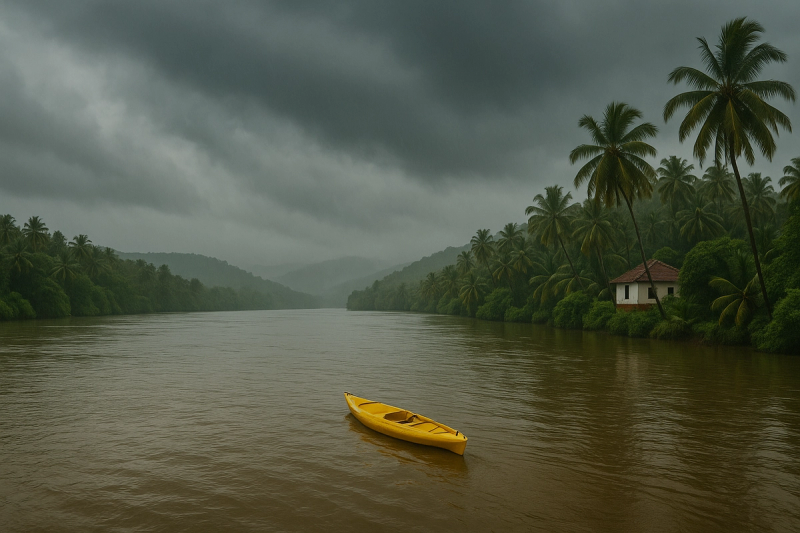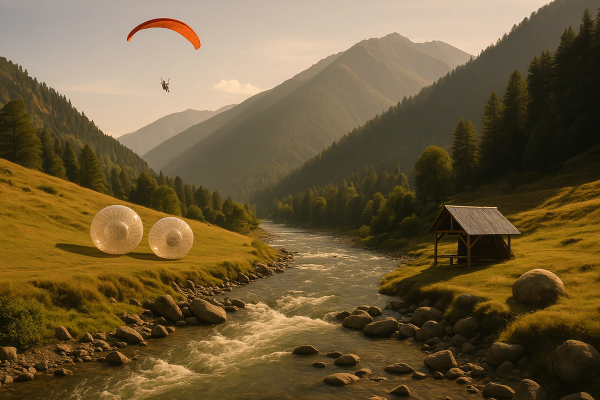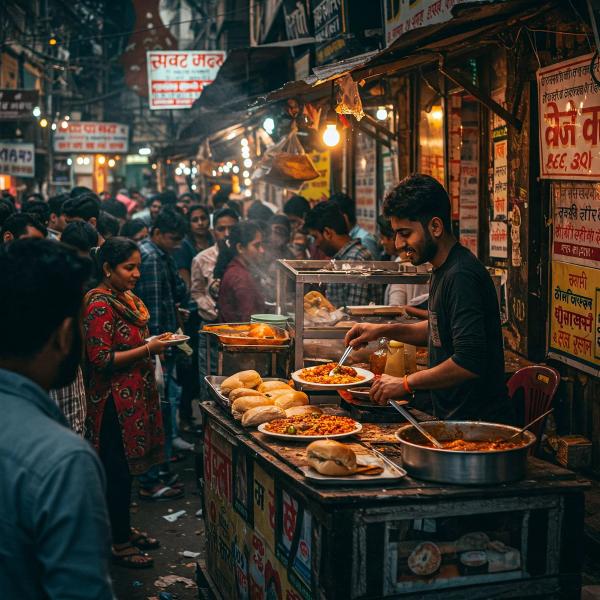Monsoon Kayaking in Goa: Backwater Routes, Safety & Tips — what it honestly feels like (and how you can do it too)#
The rains in Goa aren’t just rains. They’re drama. Thick grey clouds rolling in from the sea, mangroves breathing like they’ve woken up after a long nap, the smell of wet earth mixing with fish curry somewhere nearby… and everything slows down, but also becomes more alive. Kayaking in this monsoon mood isn’t like beach-hopping (which anyway is mostly shut during the season). It’s quieter, calmer, a bit prankish sometimes when wind suddenly flips, and honestly, it’s the kind of thing that sticks with you. If you’ve been thinking about paddling through Goa’s backwaters while everyone else is posting cafe reels in Anjuna, um, you’re on the right track.¶
Why monsoon kayaking in Goa is such a vibe (and not just for Insta)#
During monsoon, the backwaters are fuller, mangrove roots peek out like fingers, and birds just go off — kingfishers, egrets, cormorants. Fishermen are back with their nets, you hear Konkani, Marathi, English all mingling. And the best part? No crowd. You get that soft rain tapping your life jacket, that peaceful “shhh” of paddles slicing water, sometimes a cheeky crab pops up on a branch watching you like a chotu guard. It’s not perfect — winds change fast, visibility dips, sometimes a sudden downpour makes you question life choices — but that’s also the fun. Monsoon brings personality. Go with it, you know.¶
Backwater routes that actually work in the rains#
Quick thing before routes — most beach water sports are suspended June to September because the sea gets too rough. Backwaters are the safe-ish alternative if done with proper guides, gear, and tide timing. There are many little creeks in Goa but these are the ones that keep popping up among local paddlers and tour operators.¶
Mandovi River — Ribandar to Chorao & Divar loop#
Classic monsoon paddle. You launch near Ribandar causeway, slide along the mangroves, and make a loop towards Chorao island or Divar, depending on current. Bird action is solid around the Dr. Salim Ali Bird Sanctuary area. Keep it low-key, don’t blast music, birds spook easily. Tides matter here — aim for slack tide near sunrise or late afternoon. If you see a small boat wave you to wait, it’s probably a fisher checking nets. Respect that. Quick note: parts of the sanctuary are regulated, and some areas aren’t for casual entry. Stick to routes the local operators use, they usually have permissions where needed and know which channels are okay.¶
Cumbarjua Canal — croc territory (go respectful, seriously)#
This canal links Mandovi and Zuari and is famous for mugger crocodiles basking on muddy banks. Don’t panic, don’t dangle hands in water, don’t become that viral clip everyone trolls. They’re used to seeing boats but they’re still wild animals. Keep 15–20 meters distance minimum, no feeding, no shouting. Most guided trips here are timed with tides and light winds. If thunder shows up, bail. The canal has a bit of current when tides flip, so beginners should stick to short sections and follow guide signals. Amazing route when done right — you get this gothic monsoon vibe that’s pure Konkan.¶
Sal River — Assolna to Betul, backwater easy mode#
South Goa’s Sal River is gentle on most monsoon days. Launch near Assolna village or Orlim side, drift past moored fishing boats, palms leaning into water like they’re curious. Birdlife’s steady, and the sunset glow along Sal is chef’s kiss when clouds break. If you paddle towards Betul, don’t go too close to the river mouth when the sea is angry, it’s not the time to play hero. For beginners who want low effort, Sal is my go-to recomendation.¶
Nerul Creek — mangroves, colourful homes, and quick paddles#
Just off the Nerul bridge near Candolim, this creek snakes past bright houses and small fishing jetties. It’s short, friendly, and perfect for 90-minute paddles when you don’t want to commit to a full expedition. Tides can be a bit cheeky, so plan start times around slack tide and watch wind gusts funnelling under the bridge. You’ll see graffiti walls, tiny shrines, sometimes kids splashing in rain like it’s a festival. Good for weekday mornings when traffic’s low.¶
Chapora River — Siolim to Morjim sandbanks#
Chapora looks moody in monsoon. The sandbanks around Morjim show up and disappear depending on tide, and fishers set long lines that can be sneaky. If your paddle taps a nylon line, stop, reverse slowly, and adjust course. Don’t be the person who tears someone’s net. Launch from Siolim, go upstream a bit, or down towards the Morjim side but avoid the mouth if the surf’s heavy. You’ll get these wide, calm sections where the world just goes still. That’s the spot to breathe.¶
Aldona bends on Mapusa River — old-Goa feels#
Mapusa River around Aldona is underrated. Curvy bends, old churches peeping through the trees, sometimes a rain-white sky that makes everything look cinematic. Locals here are chill if you’re respectful. Try early morning paddles when the wind hasn’t woken up yet. Again, tide is king — you don’t want to fight currents the whole way and come back with noodle arms.¶
Current safety scene and updates you should actually check#
Monsoon rules in Goa change a bit year to year, but general pattern holds. Beach water sports are mostly suspended June–September. Lifeguards (Drishti Marine) put out daily flags and warnings for beaches — many will be red or black on stormy days. Inland kayaking, when done in creeks and rivers away from the sea, continues with proper operators who monitor weather through IMD alerts and wind apps. On orange/red IMD days, most decent guides cancel or reschedule. Honestly, a cancelled paddle is not a fail — it’s a flex on your risk management.
As of 2025, typical operators stick to small group sizes, proper PFDs (life jackets), and will brief you on crocodile etiquette if you’re near Cumbarjua. Zuari and Mandovi can have barge movement, even in rains — wake from barges can wobble a kayak, so face the wake, keep paddles ready, and don’t panic. Lightning is a hard no. If you see lightning and hear thunder within 30 seconds, get off the water fast. Also, monsoon trees drop branches randomly — avoid hugging overhanging boughs during gusts. Oh and leeches? Rare in the boats. More of a forest trail thing.¶
- Non‑negotiables I keep telling folks (and myself): wear a PFD properly buckled, no alcohol, keep a whistle on your jacket, bright clothing so you’re visible, phone in waterproof pouch, dry bag for keys and documents.
- Check IMD nowcast for Goa and wind apps like Windy/Windfinder 2 hours before launch. If gusts are spiking over 15 knots and you’re a beginner, just chill, go have poi and ros omelette instead.
- Tide timing matters. Slack tide around high or low is easiest. Mid‑tide runs can be a workout. Ask your guide to explain flood vs ebb for the specific creek.
- Croc protocol: 15–20 m distance, hold position if guide signals, no splashing around them, don’t try for a closeup. If you see a baby croc, assume mama is somewhere. Be respectful, don’t be dumb.
- Barges and ferries: cross their path only behind them, at a distance. Their wake is bigger than it looks. If you get hit by choppy water, keep paddling lightly and face the waves.
Gear that saved my mood when the rain went full filmy#
Keep it simple and waterproof-ish. Quick-dry tee or rash guard, shorts, light rain jacket you can stuff away, cap or visor for drizzle, sunglasses because glare is a thing even under clouds, and strapped sandals or booties. Bring a small towel. Phone in a proper TPU pouch with lanyard. Dry bag for wallet, keys, snacks. Action camera if you want, chest mount safest. Energy snack — chikki, bananas, ORS sachet. Insect repellent (dengue season gets real), sunscreen because yes you can get burnt under clouds. If you wear specs, anti-fog wipes help. If you’re prone to seasickness, ginger candy works for some people. Guides normally carry extra paddles and first aid, but carry your own basics too. Oh and don’t forget a garbage bag to bring back any trash you generate. Mangroves are not your dustbin, bhai.¶
Costs right now & booking without getting fleeced#
Prices move a bit by operator and route, but ballpark as of this year? Group paddles in backwaters usually land between ₹1,200 and ₹2,500 per person for 1.5–2 hours. Private trips are ₹3,000–₹4,500 depending on duration, route, and whether transfers are included. Sunrise or sunset sessions sometimes cost a smidge extra. If someone quotes you ₹6,000 for a basic 90‑minute paddle with no special route, hmm, ask what’s included — good operators justify with smaller groups, safety, photos, and proper tide windows. Rentals without guide aren’t common in monsoon for safety reasons, and honestly, not advised. Book via the operator’s official website/WhatsApp number or verified Google listing. “Cash only, no receipt” is a red flag these days. Also, travel insurance that covers adventure sports is smart, even if it adds a few hundred rupees — it’s one of those costs you hope you never use.¶
Where to stay: river-facing stays, homestays, typical prices#
Monsoon is off‑season for the beach, which means deals pop up near the rivers. Budget homestays go ₹800–₹2,000 per night if you’re okay with simple rooms and maybe a fan that squeaks a little. Mid‑range boutique stays ₹2,500–₹6,000, and some lovley riverfront properties can be ₹4,500–₹12,000 depending on location and weekend demand. North Goa has spots along Chapora and Nerul that vibe with kayakers. South Goa around Assolna, Orlim, Cavelossim gives you Sal River access. If you want old-world charm, Divar or Aldona homestays feel local and calm, but plan transport better there. Basic tip: choose stays with covered parking and a small drying area — monsoon means wet gear all day. Ask about backup power, Wi‑Fi stability, and proximity to launch points. Many hosts can arrange paddles with trusted guides — saves time and confusion.¶
Getting around when everything’s wet and buses are doing their own thing#
Two airports now — Dabolim (GOI) and Mopa (GOX). Mopa is closer to North Goa and has a long drive to South Goa, Dabolim flips that. Taxis can be pricey, GoaMiles works in many parts, local unions are still strong in some areas so expect occasional negotiation. Scooters are cheaper in monsoon, ₹300–₹600 per day, but check brakes and tires before riding. Helmets always. If it’s raining like crazy, pick a small car rental instead, ₹900–₹2,500 depending on type. Buses run, but timings get funky during heavy showers. Konkan Railway is scenic but monsoon timetables can slow trains and occasional delays happen if there’s a landslide or waterlogging. Keep buffer time. Also, maps sometimes mislead on little village roads — ask locals for directions, they’ll often guide you with “left after that banyan tree” kind instructions that actually work.¶
Food that hits different in the rains (and keeps you happy after paddling)#
Monsoon is for hot plates and comfort things. Fish thali is staple — mackerel or pomfret when fresh, curry rice, tisryo clams if you’re lucky. Ros omelette with poi bread on a drizzly evening is elite behaviour. Cafreal and xacuti bring warmth. In season, try patoleo — rice and jaggery steamed in turmeric leaves, very monsoon, very nostalgic. Urrak shows up early rains, feni later — drink responsibly, not before paddling. Small bakeries open at weird hours on stormy days, you’ll find treasure like freshly baked poie and buns. Eat where local workers are eating, you’ll get honest food and fair prices. Avoid fancy places when skies go mad if you hate waiting — backwaters don’t care about your reservation times.¶
Events & local vibes that pair nicely with paddling#
Monsoon isn’t dead in Goa. Sao Joao (around late June) has folks leaping into wells with flower crowns — joyous chaos. Bonderam on Divar Island in August — flags, floats, music, so much colour. Chikhal Kalo in Marcel in July — a mud festival where people wrestle and slide like happy toddlers, no shame. You can plan a morning paddle and make an afternoon event if the rain gods bless you. Check dates localy because sometimes they shuffle based on rain and community schedules.¶
Beginner vs intermediate — pick your route smartly#
- Beginner: Sal River short loop near Assolna, Nerul Creek quick sessions, Aldona gentle bends at slack tide.
- Intermediate: Mandovi Ribandar–Chorao–Divar loop with tide awareness, parts of Chapora near Siolim avoiding the mouth.
- Advanced-ish with strict guide: Cumbarjua Canal croc viewing at proper distance, sections of Zuari where barge wake and wind can be tricky. Not for day-one paddlers.
Levels aren’t just about muscles. It’s about how you handle surprise wind, rain curtains, and reading water. If you’re new, start short. Later, add a mildly challenging route. It’s like learning to make a perfect chai — takes a couple tries to get the vibe right.¶
Etiquette 101: mangroves, birds, and fishers are not your props#
Mangroves protect the coast, breed fish, and shelter birds — please don’t break roots or push in too close for a selfie. Keep voices low near bird areas. Bring back all garbage, even if it’s just an energy bar wrapper. Ask fishers if you can pass near their nets — sometimes they’ll signal which side to go. And no blasting Bluetooth speakers, yaar, it’s nature not a club. Also, a quick “Namaskar” or a smile to locals goes a long way. If you drop something, pick it up. If you see trash, pick a bit of it up too. It’s small, but it adds up.¶
FAQs people keep asking (and they’re good questions)#
Is it safe in heavy rains? It can be, but only with legit operators who are monitoring IMD and wind patterns. On red alert days, don’t push it. Safety is not a flex.
What about crocodiles? Respect them. Stay 15–20 m away, keep hands in, no sudden splashes. Local guides know basking spots. If you’re nervous, pick a non‑croc route, there are plenty.
Do kids go? Some operators allow kids 8+ on backwaters with proper jackets and close supervision, calm routes only. Not during thunderstorms or high wind.
Leeches and snakes? Leeches are mostly a forest trail issue, not so much in kayaks. Snakes exist in mangroves but they don’t usually bother paddlers. Don’t touch wildlife, simple.
Network? Jio and Airtel work in most areas, but Cumbarjua has patchy pockets. Tell someone your route, share live location if possible, but don’t rely solely on it.
Permits? In regular backwaters, not usually. For sanctuary zones, operators handle permissions or avoid restricted channels. Always follow their route.
Can I paddle solo? In monsoon, not advisable unless you’re very experienced and local. Group is safer. Also, if you capsize (rare in sit‑on‑top kayaks), stay calm, flip and re‑enter — guides will usually demonstrate before launch.¶
2–3 day monsoon paddle ideas if you want a mini plan#
- Day 1: Early morning Nerul Creek, breakfast poi and ros omelette in Candolim, nap, then sunset Sal River short loop.
- Day 2: Mandovi Ribandar–Chorao route at slack tide, lunch thali near Old Goa, explore churches, rain coffee, and an evening drive across the causeway.
- Day 3: If weather plays nice, Chapora around Siolim, or switch to Aldona bends if wind is up. Keep Sao Joao/Bonderam on calendar if dates match.
Mix paddles with food and tiny village walks. Leave space for rain delays, because monsoon has its own schedule. If a day gets washed out, go cafe‑hopping or attend a local event. Don’t cram.¶
Little things that make the whole trip smoother#
Carry small cash for chai stops where UPI gets moody in rain. Keep spare clothes in the car. After paddle, rinse gear with fresh water so it doesn’t smell like ancient fish. Tip guides if they took good care — the quiet paddler who kept an eye on everyone deserves it. Keep your phone brightness low during drizzle so you don’t blind yourself when clouds open up. Hydrate even when it’s cool. And please don’t try to save time by driving through flooded patches you don’t know — locals have stories and they’re not cute. Btw, watch for slippery tiles in homestays, monsoon turns floors into skating rinks if you come in with wet sandals.¶
Final paddles & parting thoughts#
Monsoon kayaking in Goa is not the obvious choice for many travellers, which is kinda why it’s special. It’s slower, it’s moodier, it’s more local. If you let the tide decide a little, listen to the wind, and go with guides who care more about safety than reels, you’ll have that good day where everything just lines up — clouds thin out, water goes glassy, birds go busy, and your paddle rhythm feels like a song. If it rains too much and you end up sipping chai under a tin roof listening to drop‑drop sounds… that’s also part of the story. Either way, Goa in the rains will get under your skin, in a good way. For more travel stories and practical guides, I keep checking AllBlogs.in — lots of Indian travel inspo and grounded info there too.¶














